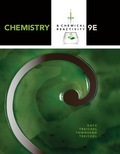
Concept explainers
Hexane (C6H14, density = 0.766 g/cm3), perfluoro-hexane (C6F14, density = 1.669 g/cm3), and water are immiscible liquids; that is, they do not dissolve in one another. You place 10 mL of each in a graduated cylinder, along with pieces of high-density polyethylene (HDPE, density = 0.97 g/cm3), polyvinyl chloride(PVC, density = 1.36 g/cm3), and Teflon (density = 2.3 g/cm3). None of these common plastics dissolves in these liquids. Describe what you expect to see.
Trending nowThis is a popular solution!

Chapter 1 Solutions
Chemistry & Chemical Reactivity
Additional Science Textbook Solutions
Physics for Scientists and Engineers: A Strategic Approach, Vol. 1 (Chs 1-21) (4th Edition)
Human Biology: Concepts and Current Issues (8th Edition)
Organic Chemistry
Applications and Investigations in Earth Science (9th Edition)
Biology: Life on Earth (11th Edition)
- Please correct answer and don't used hand raitingarrow_forwardthis is an organic chemistry question please answer accordindly!! please post the solution in your hand writing not an AI generated answer please draw the figures and structures if needed to support your explanation hand drawn only!!!! answer the question in a very simple and straight forward manner thanks!!!!! im reposting this please solve all parts and draw it not just word explanations!!arrow_forward2B: The retrosynthetic cut below provides two options for a Suzuki coupling, provide the identities of A, B, C and D then identify which pairing is better and justify your choice. O₂N. Retro-Suzuki NO2 MeO OMe A + B OR C + Darrow_forward
- this is an organic chemistry question please answer accordindly!! please post the solution in your hand writing not an AI generated answer please draw the figures and structures if needed to support your explanation hand drawn only!!!! answer the question in a very simple and straight forward manner thanks!!!!! im reposting this please solve all parts and draw it not just word explanations!!arrow_forwardShow work. don't give Ai generated solution and don't copy answer anywherearrow_forwardShow work. don't give Ai generated solutionarrow_forward
- Show work. Don't give Ai generated solutionarrow_forwardA buffered solution containing dissolved aniline, CH,NH2, and aniline hydrochloride, CH, NH, Cl, has a pH of 5.41. Determine the concentration of CH, NH in the solution if the concentration of CH, NH, is 0.305 M. The pK of aniline is 9.13. [CHẠNH] = Calculate the change in pH of the solution, ApH, if 0.375 g NaOH is added to the buffer for a final volume of 1.40 L. Assume that any contribution of NaOH to the volume is negligible. ApH = Marrow_forwardShow work. don't give Ai generated solutionarrow_forward
 Chemistry: The Molecular ScienceChemistryISBN:9781285199047Author:John W. Moore, Conrad L. StanitskiPublisher:Cengage Learning
Chemistry: The Molecular ScienceChemistryISBN:9781285199047Author:John W. Moore, Conrad L. StanitskiPublisher:Cengage Learning General Chemistry - Standalone book (MindTap Cour...ChemistryISBN:9781305580343Author:Steven D. Gammon, Ebbing, Darrell Ebbing, Steven D., Darrell; Gammon, Darrell Ebbing; Steven D. Gammon, Darrell D.; Gammon, Ebbing; Steven D. Gammon; DarrellPublisher:Cengage Learning
General Chemistry - Standalone book (MindTap Cour...ChemistryISBN:9781305580343Author:Steven D. Gammon, Ebbing, Darrell Ebbing, Steven D., Darrell; Gammon, Darrell Ebbing; Steven D. Gammon, Darrell D.; Gammon, Ebbing; Steven D. Gammon; DarrellPublisher:Cengage Learning Chemistry for Engineering StudentsChemistryISBN:9781337398909Author:Lawrence S. Brown, Tom HolmePublisher:Cengage Learning
Chemistry for Engineering StudentsChemistryISBN:9781337398909Author:Lawrence S. Brown, Tom HolmePublisher:Cengage Learning


